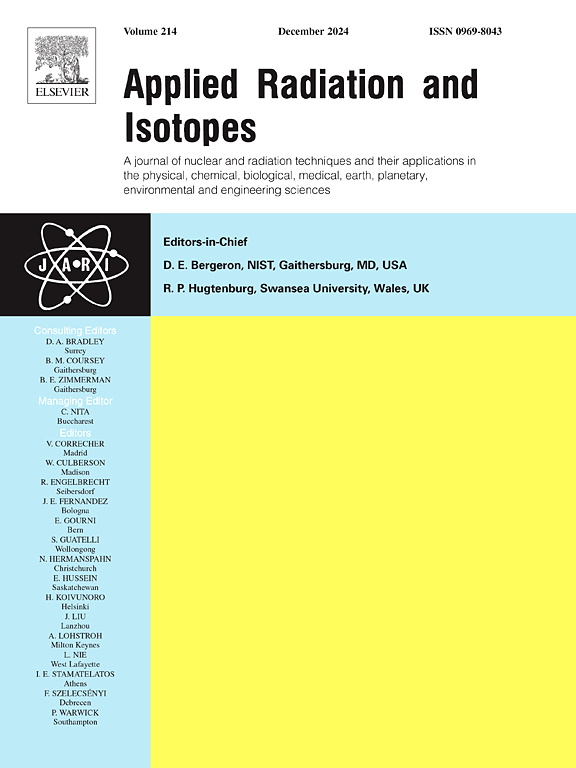Study of positron emission from 36Cl
IF 1.6
3区 工程技术
Q3 CHEMISTRY, INORGANIC & NUCLEAR
引用次数: 0
Abstract
The absolute intensity of the weak branch for positron emission from 36Cl was evaluated using a β-γ coincidence technique. A liquid sample with known activity of 36Cl was embedded in scintillation cocktail and measured in a 4παβ(LS)-γ(HPGe) system that comprises a Liquid Scintillator (LS) detector and a High-Purity Germanium (HPGe) detector. The LS detector includes a photo-reflector assembly that holds the liquid sample and ensures high efficiency for β particles. The recorded timestamp and energy for β and γ events provided a highly effective mechanism for filtering out events that originated from outside the volume of the measured sample, thereby allowing a clear observation of the 511-keV γ-rays associated with positron emission from 36Cl. Hence, the positron branch intensity can be evaluated directly in a practically background-free environment. The system was calibrated for detecting β particles and γ rays at relevant energies using radioactive sources having identical geometry as employed in the 36Cl sample measurement. The absolute intensity of the positron emission was found to be (1.62 ± 0.15) × 10−5, in agreement with the values appearing in the literature.
36Cl正电子发射的研究
利用β-γ重合技术对36Cl正电子发射弱分支的绝对强度进行了计算。将已知36Cl活性的液体样品包埋在闪烁混合物中,并在由液体闪烁体(LS)检测器和高纯锗(HPGe)检测器组成的4παβ(LS)-γ(HPGe)体系中进行测量。LS检测器包括一个光反射器组件,用于保持液体样品并确保β粒子的高效率。记录的β和γ事件的时间戳和能量提供了一种非常有效的机制,可以过滤掉来自被测样品体积外的事件,从而可以清楚地观察到与36Cl正电子发射相关的511-keV γ射线。因此,正电子分支强度可以在实际无背景的环境中直接评估。对该系统进行了校准,以检测相关能量的β粒子和γ射线,使用的放射源具有与36Cl样品测量相同的几何形状。正电子发射的绝对强度为(1.62±0.15)× 10−5,与文献中出现的值一致。
本文章由计算机程序翻译,如有差异,请以英文原文为准。
求助全文
约1分钟内获得全文
求助全文
来源期刊

Applied Radiation and Isotopes
工程技术-核科学技术
CiteScore
3.00
自引率
12.50%
发文量
406
审稿时长
13.5 months
期刊介绍:
Applied Radiation and Isotopes provides a high quality medium for the publication of substantial, original and scientific and technological papers on the development and peaceful application of nuclear, radiation and radionuclide techniques in chemistry, physics, biochemistry, biology, medicine, security, engineering and in the earth, planetary and environmental sciences, all including dosimetry. Nuclear techniques are defined in the broadest sense and both experimental and theoretical papers are welcome. They include the development and use of α- and β-particles, X-rays and γ-rays, neutrons and other nuclear particles and radiations from all sources, including radionuclides, synchrotron sources, cyclotrons and reactors and from the natural environment.
The journal aims to publish papers with significance to an international audience, containing substantial novelty and scientific impact. The Editors reserve the rights to reject, with or without external review, papers that do not meet these criteria.
Papers dealing with radiation processing, i.e., where radiation is used to bring about a biological, chemical or physical change in a material, should be directed to our sister journal Radiation Physics and Chemistry.
 求助内容:
求助内容: 应助结果提醒方式:
应助结果提醒方式:


